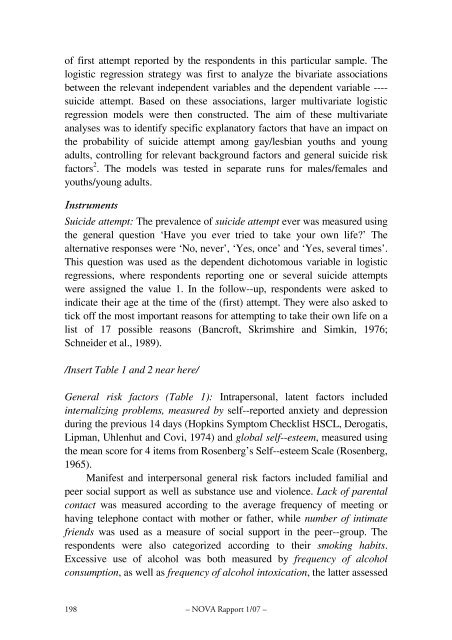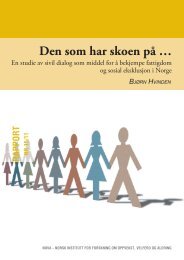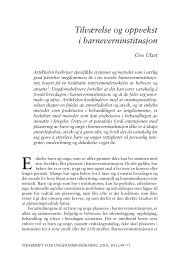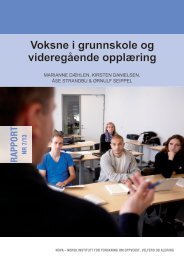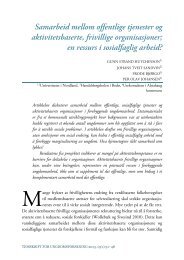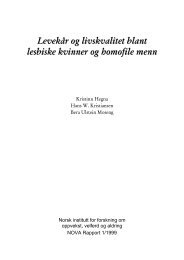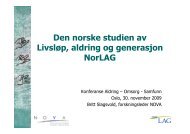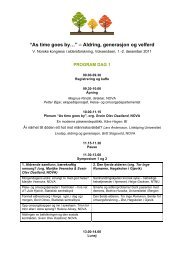Betydningen av seksuell erfaring, tiltrekning og identitet for ...
Betydningen av seksuell erfaring, tiltrekning og identitet for ...
Betydningen av seksuell erfaring, tiltrekning og identitet for ...
You also want an ePaper? Increase the reach of your titles
YUMPU automatically turns print PDFs into web optimized ePapers that Google loves.
of first attempt reported by the respondents in this particular sample. The<br />
l<strong>og</strong>istic regression strategy was first to analyze the bivariate associations<br />
between the relevant independent variables and the dependent variable ----<br />
suicide attempt. Based on these associations, larger multivariate l<strong>og</strong>istic<br />
regression models were then constructed. The aim of these multivariate<br />
analyses was to identify specific explanatory factors that h<strong>av</strong>e an impact on<br />
the probability of suicide attempt among gay/lesbian youths and young<br />
adults, controlling <strong>for</strong> relevant background factors and general suicide risk<br />
factors 2 . The models was tested in separate runs <strong>for</strong> males/females and<br />
youths/young adults.<br />
Instruments<br />
Suicide attempt: The prevalence of suicide attempt ever was measured using<br />
the general question ‘H<strong>av</strong>e you ever tried to take your own life?’ The<br />
alternative responses were ‘No, never’, ‘Yes, once’ and ‘Yes, several times’.<br />
This question was used as the dependent dichotomous variable in l<strong>og</strong>istic<br />
regressions, where respondents reporting one or several suicide attempts<br />
were assigned the value 1. In the follow--up, respondents were asked to<br />
indicate their age at the time of the (first) attempt. They were also asked to<br />
tick off the most important reasons <strong>for</strong> attempting to take their own life on a<br />
list of 17 possible reasons (Bancroft, Skrimshire and Simkin, 1976;<br />
Schneider et al., 1989).<br />
/Insert Table 1 and 2 near here/<br />
General risk factors (Table 1): Intrapersonal, latent factors included<br />
internalizing problems, measured by self--reported anxiety and depression<br />
during the previous 14 days (Hopkins Symptom Checklist HSCL, Der<strong>og</strong>atis,<br />
Lipman, Uhlenhut and Covi, 1974) and global self--esteem, measured using<br />
the mean score <strong>for</strong> 4 items from Rosenberg’s Self--esteem Scale (Rosenberg,<br />
1965).<br />
Manifest and interpersonal general risk factors included familial and<br />
peer social support as well as substance use and violence. Lack of parental<br />
contact was measured according to the <strong>av</strong>erage frequency of meeting or<br />
h<strong>av</strong>ing telephone contact with mother or father, while number of intimate<br />
friends was used as a measure of social support in the peer--group. The<br />
respondents were also categorized according to their smoking habits.<br />
Excessive use of alcohol was both measured by frequency of alcohol<br />
consumption, as well as frequency of alcohol intoxication, the latter assessed<br />
198<br />
– NOVA Rapport 1/07 –


